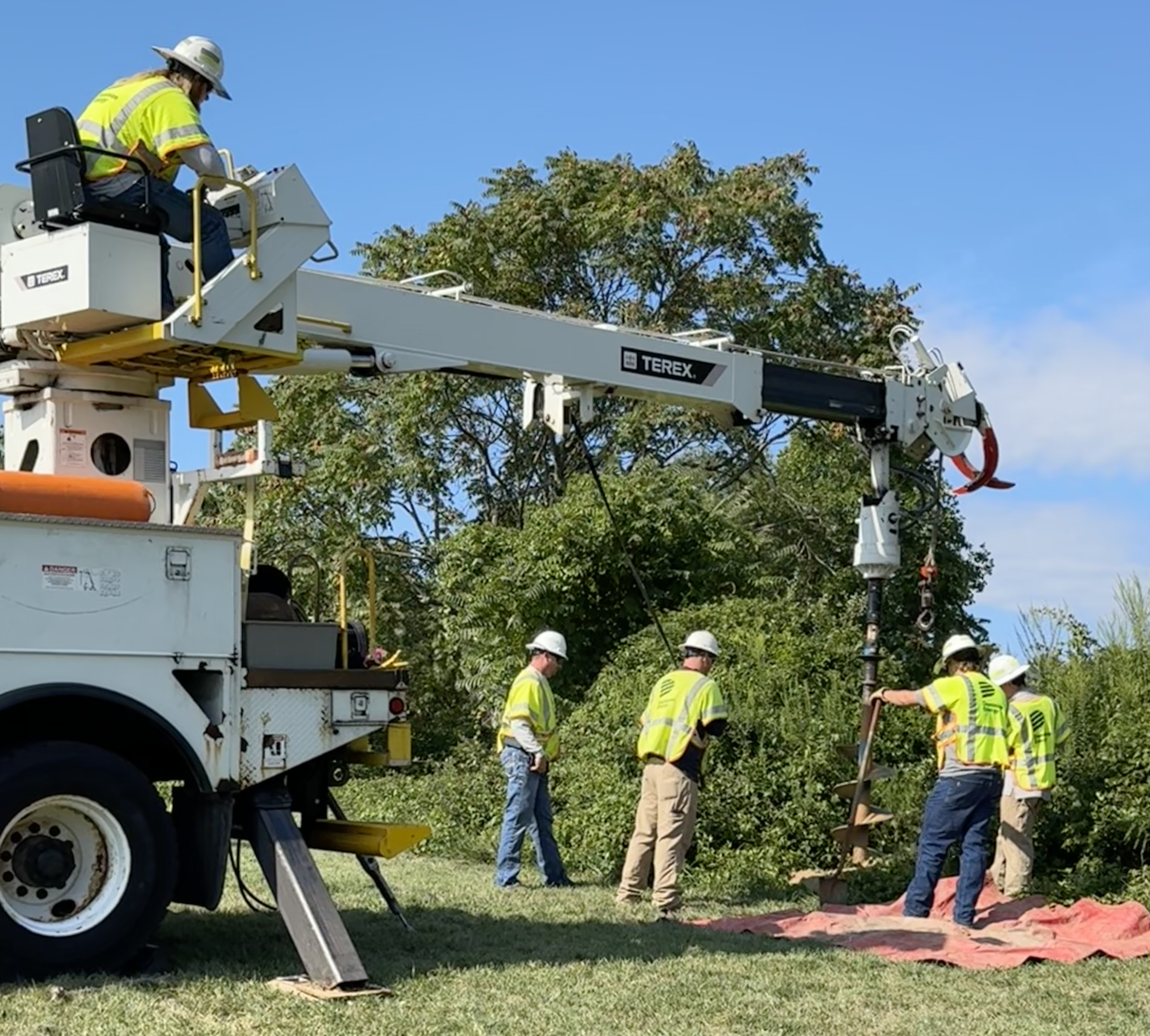Recently, Dominion Energy teamed up with Fairfax County Park Authority’s Natural Resources Branch and Laurel Hill Park volunteers to provide more potential nesting space for Ospreys (Pandion haliaetvus). With multiple nesting pairs of the impressive raptors in the area, typically raising two or three chicks each season, it is hoped that additional nesting platforms will encourage young birds to return, pair, and breed here in coming years.
 Ryce Zink operates auger to create deep hole to accommodate platform pole
Ryce Zink operates auger to create deep hole to accommodate platform pole
Dominion Energy’s manager, John Higbee shares that they regularly look for community service projects in which to participate. “Giving ospreys a safe place to nest keeps them from nesting on our facilities and protects our service to customers. Ospreys nesting here is evidence of strong ecosystems, and evidence that efforts under the Chesapeake Bay Act are working.” The company donated recycled treated utility poles, use of specialized installation equipment and their crew’s work to erect two nesting platforms in Lorton’s Laurel Hill Park.
Watching a pair nesting on a light pole at the former Nike missile site over several seasons led Park Area 4 Maintenance and park volunteers to team up for a solo venture at platform installation last year. (See The Connection, Oct. 19, 2023). The team was successful in raising a 60 foot pole using only available equipment. Wanting to raise more platforms but realizing the shortfalls of their equipment, the team looked with envy at Dominion Energy’s specialized digger derrick equipment and expert pole installation crews. When the County’s wildlife ecologist Dave Lawlor reached out for a helping hand, Dominion Energy’s construction and operations supervisor, Jonathan Copus responded positively.
Volunteer, Bill Beletsky of Springfield, built the nest boxes for placement on the poles, following a Cornell Ornithology Lab design for two boxes. For a third box, he made minor adjustments of his own design, including to the resting perch for the male to alight near the female laying on the eggs, and a central attachment design on the pole. The boxes were attached to the poles while on the ground; a few sticks added to the box bed to encourage nest building. Then the full nesting platform and pole were hoisted into a six-foot hole augured to receive it.
Ospreys inhabit locations thorough-out the world, making a come-back from the ravages of the insecticide DDT in the 1960-70s, which devastated their numbers. The world’s heaviest concentration of nesting Osprey’s now is in our own Chesapeake Bay region. The Bay area supports 10,000 to 12,000 breeding pairs. As their numbers grow, more of the elegant fish hawks, which eat only fish, are making homes near other Virginia waterways. Osprey’s are finding local rivers, lakes, and wetlands acceptable places to raise their young with their bounty of fresh water fish.
There are concerns about Virginia’s menhaden fishery impacting food sources for the birds and other creatures. Menhaden are an important food source for ospreys and many predator fish, bald eagles, dolphins, and whales.
Commercial interests harvest menhaden for use as fertilizers, animal feed, and bait for crab and lobster fisheries.
But the osprey population is in trouble in parts of the Chesapeake Bay where ospreys are producing far too few nestlings to sustain their numbers, said Robin Todd of the Maryland Ornithological Society. Recent research by Bryan Watts of William and Mary’s Center for Conservation Biology indicates that a major cause is the industrial fishing of menhaden, a key food source for these birds.
Ospreys typically build nests near fish sources; on top of trees, telephone poles, buoys, or human-made nesting platforms. The Lorton platforms are within birds’ view of the Occoquan River, Lake Mercer, Burke Lake, and Huntsman Lake. Nests constructed by ospreys are large and make use of sticks, reeds, and grasses. The birds are notorious for also using man-made nylon or plastic netting, plastic bags and other garbage, often with disastrous results, when talons, or necks of young chicks, get stuck in the unyielding materials.
In a successful breeding season, a pair will hatch two or three chicks, feed them through fledging, then teach them to hunt on their own before their migration south for the winter.
Once they successfully raise chicks in a nest, the osprey pair will return to it year after year. As pairs successfully raise more and more chicks, available nesting spots for young birds are in demand. The Lorton volunteers hope the three new nest platforms installed in Laurel Hill Park will be occupied when young birds return from the Caribbean and South America next March.
